Health Variations 2: Diabetes Case Study and Nursing Assessment
VerifiedAdded on 2023/06/06
|8
|2141
|302
Case Study
AI Summary
This case study focuses on a patient, Ben, diagnosed with type 1 diabetes and prescribed Novo Rapid insulin. It explores the eleven components of a valid insulin medication order, the pathophysiology of type 1 diabetes, and the mechanism of action of Novo Rapid. The assignment addresses the onset, peak, and duration of action of Novo Rapid, along with its administration in relation to food intake. It also discusses the definition, causes, symptoms, and treatment of hypoglycemia. Furthermore, it highlights the importance of understanding medication, the five rights of medication administration, and the appropriate insulin pen needle length. The case study details diabetes-specific nursing assessments before and after insulin administration, including injection sites, angles, and infection control considerations. Documentation requirements and the potential physical and emotional impacts of type 1 diabetes on Ben are also examined.
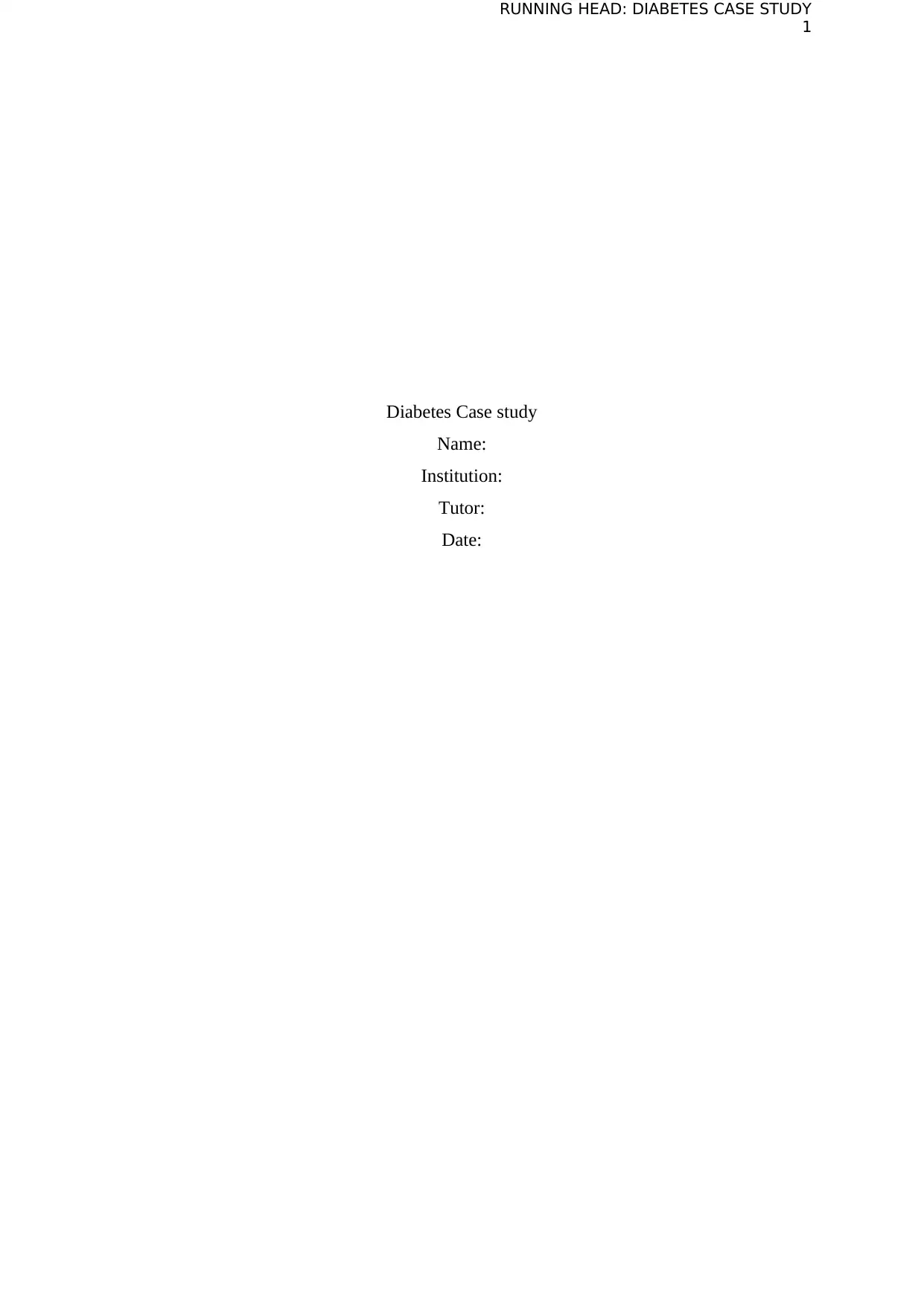
RUNNING HEAD: DIABETES CASE STUDY
1
Diabetes Case study
Name:
Institution:
Tutor:
Date:
1
Diabetes Case study
Name:
Institution:
Tutor:
Date:
Paraphrase This Document
Need a fresh take? Get an instant paraphrase of this document with our AI Paraphraser
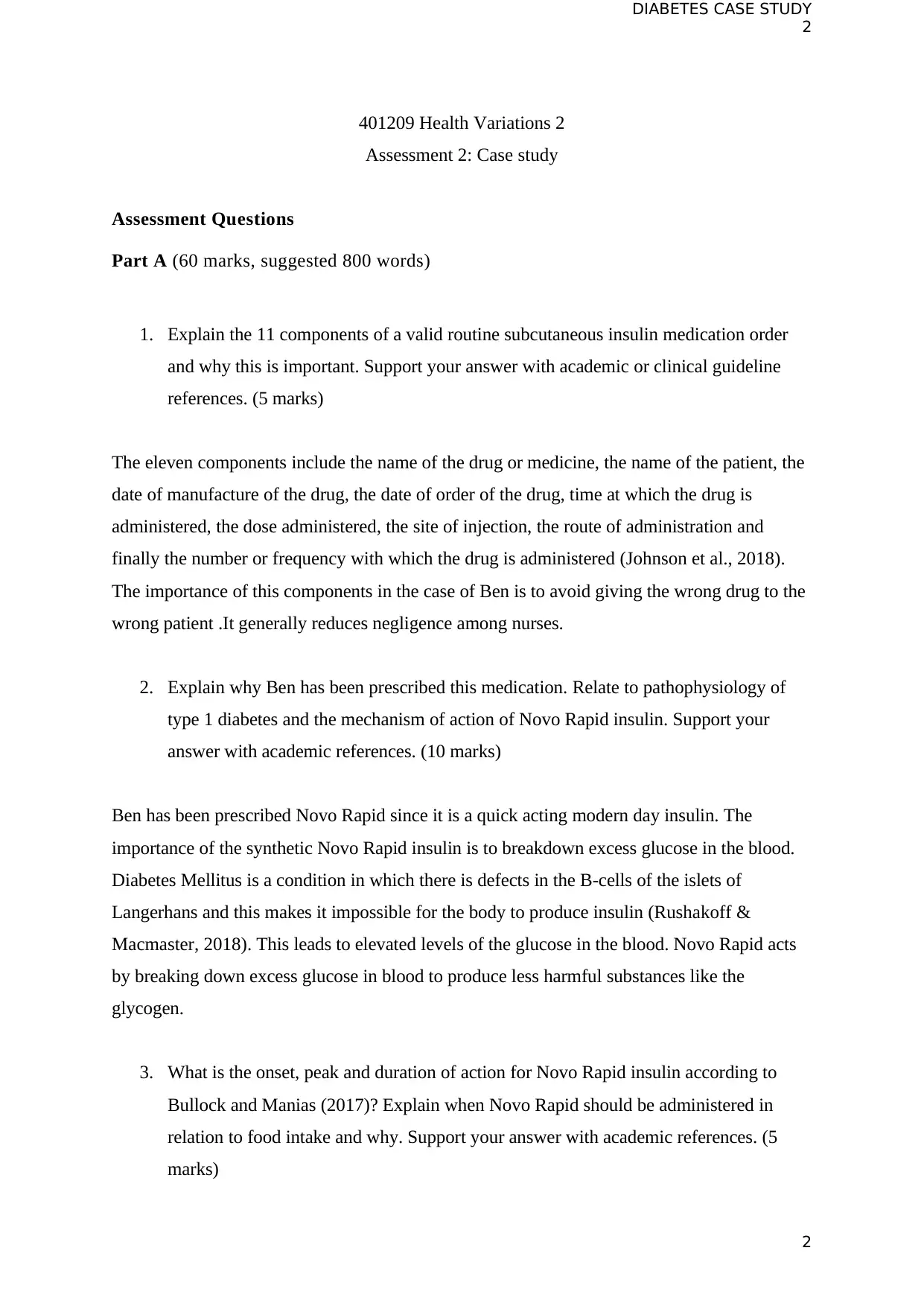
2
DIABETES CASE STUDY
2
401209 Health Variations 2
Assessment 2: Case study
Assessment Questions
Part A (60 marks, suggested 800 words)
1. Explain the 11 components of a valid routine subcutaneous insulin medication order
and why this is important. Support your answer with academic or clinical guideline
references. (5 marks)
The eleven components include the name of the drug or medicine, the name of the patient, the
date of manufacture of the drug, the date of order of the drug, time at which the drug is
administered, the dose administered, the site of injection, the route of administration and
finally the number or frequency with which the drug is administered (Johnson et al., 2018).
The importance of this components in the case of Ben is to avoid giving the wrong drug to the
wrong patient .It generally reduces negligence among nurses.
2. Explain why Ben has been prescribed this medication. Relate to pathophysiology of
type 1 diabetes and the mechanism of action of Novo Rapid insulin. Support your
answer with academic references. (10 marks)
Ben has been prescribed Novo Rapid since it is a quick acting modern day insulin. The
importance of the synthetic Novo Rapid insulin is to breakdown excess glucose in the blood.
Diabetes Mellitus is a condition in which there is defects in the B-cells of the islets of
Langerhans and this makes it impossible for the body to produce insulin (Rushakoff &
Macmaster, 2018). This leads to elevated levels of the glucose in the blood. Novo Rapid acts
by breaking down excess glucose in blood to produce less harmful substances like the
glycogen.
3. What is the onset, peak and duration of action for Novo Rapid insulin according to
Bullock and Manias (2017)? Explain when Novo Rapid should be administered in
relation to food intake and why. Support your answer with academic references. (5
marks)
DIABETES CASE STUDY
2
401209 Health Variations 2
Assessment 2: Case study
Assessment Questions
Part A (60 marks, suggested 800 words)
1. Explain the 11 components of a valid routine subcutaneous insulin medication order
and why this is important. Support your answer with academic or clinical guideline
references. (5 marks)
The eleven components include the name of the drug or medicine, the name of the patient, the
date of manufacture of the drug, the date of order of the drug, time at which the drug is
administered, the dose administered, the site of injection, the route of administration and
finally the number or frequency with which the drug is administered (Johnson et al., 2018).
The importance of this components in the case of Ben is to avoid giving the wrong drug to the
wrong patient .It generally reduces negligence among nurses.
2. Explain why Ben has been prescribed this medication. Relate to pathophysiology of
type 1 diabetes and the mechanism of action of Novo Rapid insulin. Support your
answer with academic references. (10 marks)
Ben has been prescribed Novo Rapid since it is a quick acting modern day insulin. The
importance of the synthetic Novo Rapid insulin is to breakdown excess glucose in the blood.
Diabetes Mellitus is a condition in which there is defects in the B-cells of the islets of
Langerhans and this makes it impossible for the body to produce insulin (Rushakoff &
Macmaster, 2018). This leads to elevated levels of the glucose in the blood. Novo Rapid acts
by breaking down excess glucose in blood to produce less harmful substances like the
glycogen.
3. What is the onset, peak and duration of action for Novo Rapid insulin according to
Bullock and Manias (2017)? Explain when Novo Rapid should be administered in
relation to food intake and why. Support your answer with academic references. (5
marks)
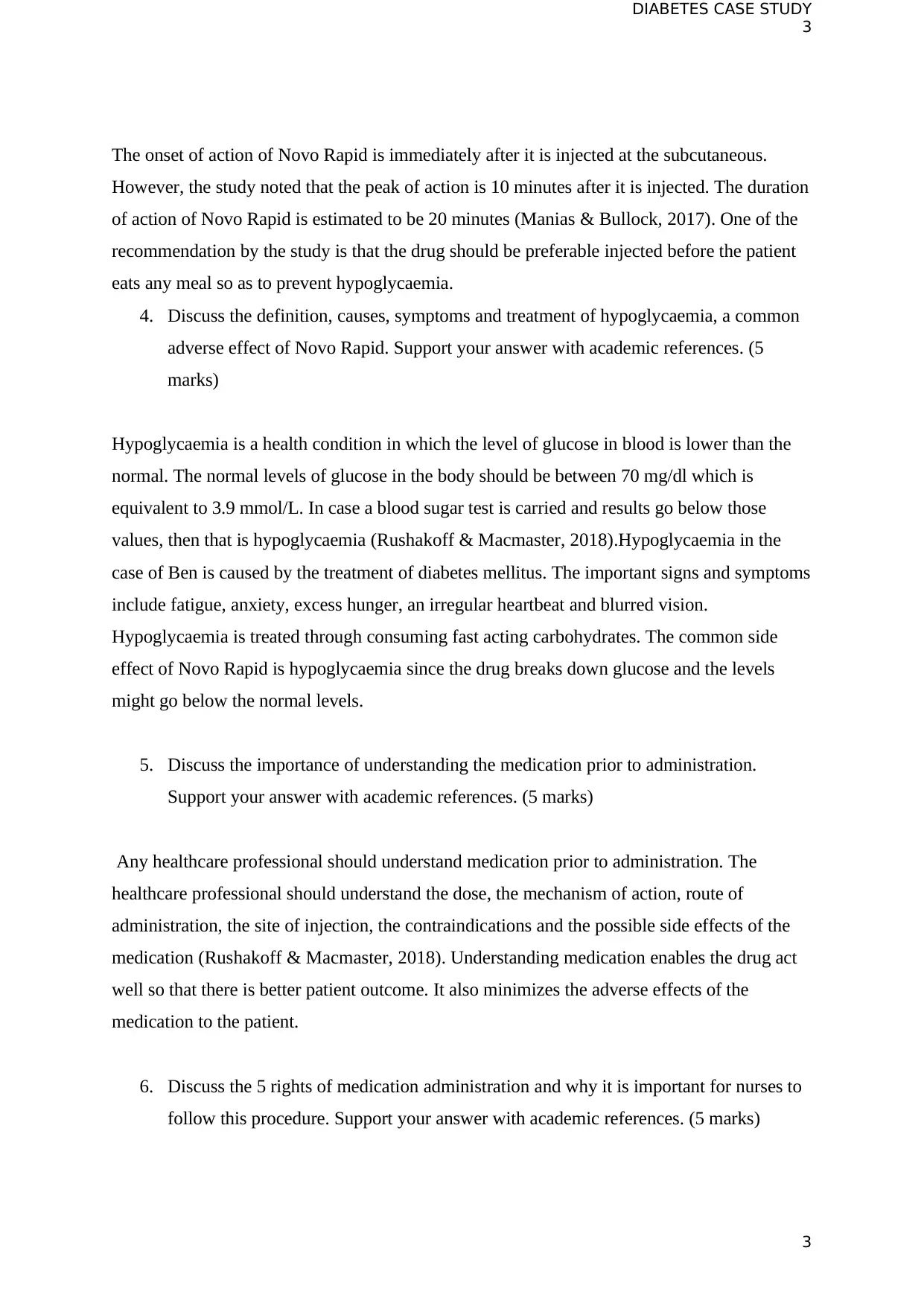
3
DIABETES CASE STUDY
3
The onset of action of Novo Rapid is immediately after it is injected at the subcutaneous.
However, the study noted that the peak of action is 10 minutes after it is injected. The duration
of action of Novo Rapid is estimated to be 20 minutes (Manias & Bullock, 2017). One of the
recommendation by the study is that the drug should be preferable injected before the patient
eats any meal so as to prevent hypoglycaemia.
4. Discuss the definition, causes, symptoms and treatment of hypoglycaemia, a common
adverse effect of Novo Rapid. Support your answer with academic references. (5
marks)
Hypoglycaemia is a health condition in which the level of glucose in blood is lower than the
normal. The normal levels of glucose in the body should be between 70 mg/dl which is
equivalent to 3.9 mmol/L. In case a blood sugar test is carried and results go below those
values, then that is hypoglycaemia (Rushakoff & Macmaster, 2018).Hypoglycaemia in the
case of Ben is caused by the treatment of diabetes mellitus. The important signs and symptoms
include fatigue, anxiety, excess hunger, an irregular heartbeat and blurred vision.
Hypoglycaemia is treated through consuming fast acting carbohydrates. The common side
effect of Novo Rapid is hypoglycaemia since the drug breaks down glucose and the levels
might go below the normal levels.
5. Discuss the importance of understanding the medication prior to administration.
Support your answer with academic references. (5 marks)
Any healthcare professional should understand medication prior to administration. The
healthcare professional should understand the dose, the mechanism of action, route of
administration, the site of injection, the contraindications and the possible side effects of the
medication (Rushakoff & Macmaster, 2018). Understanding medication enables the drug act
well so that there is better patient outcome. It also minimizes the adverse effects of the
medication to the patient.
6. Discuss the 5 rights of medication administration and why it is important for nurses to
follow this procedure. Support your answer with academic references. (5 marks)
DIABETES CASE STUDY
3
The onset of action of Novo Rapid is immediately after it is injected at the subcutaneous.
However, the study noted that the peak of action is 10 minutes after it is injected. The duration
of action of Novo Rapid is estimated to be 20 minutes (Manias & Bullock, 2017). One of the
recommendation by the study is that the drug should be preferable injected before the patient
eats any meal so as to prevent hypoglycaemia.
4. Discuss the definition, causes, symptoms and treatment of hypoglycaemia, a common
adverse effect of Novo Rapid. Support your answer with academic references. (5
marks)
Hypoglycaemia is a health condition in which the level of glucose in blood is lower than the
normal. The normal levels of glucose in the body should be between 70 mg/dl which is
equivalent to 3.9 mmol/L. In case a blood sugar test is carried and results go below those
values, then that is hypoglycaemia (Rushakoff & Macmaster, 2018).Hypoglycaemia in the
case of Ben is caused by the treatment of diabetes mellitus. The important signs and symptoms
include fatigue, anxiety, excess hunger, an irregular heartbeat and blurred vision.
Hypoglycaemia is treated through consuming fast acting carbohydrates. The common side
effect of Novo Rapid is hypoglycaemia since the drug breaks down glucose and the levels
might go below the normal levels.
5. Discuss the importance of understanding the medication prior to administration.
Support your answer with academic references. (5 marks)
Any healthcare professional should understand medication prior to administration. The
healthcare professional should understand the dose, the mechanism of action, route of
administration, the site of injection, the contraindications and the possible side effects of the
medication (Rushakoff & Macmaster, 2018). Understanding medication enables the drug act
well so that there is better patient outcome. It also minimizes the adverse effects of the
medication to the patient.
6. Discuss the 5 rights of medication administration and why it is important for nurses to
follow this procedure. Support your answer with academic references. (5 marks)
⊘ This is a preview!⊘
Do you want full access?
Subscribe today to unlock all pages.

Trusted by 1+ million students worldwide
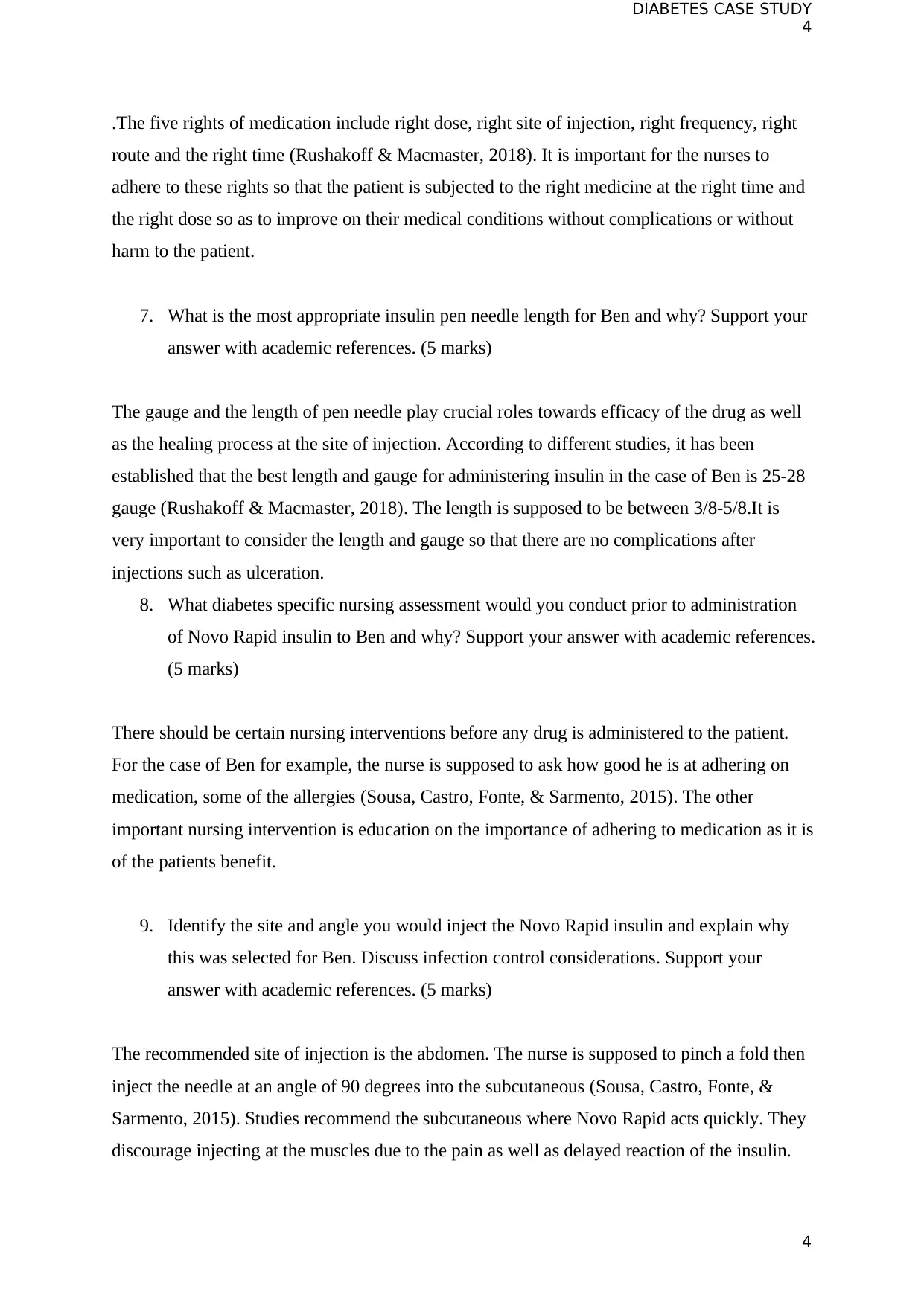
4
DIABETES CASE STUDY
4
.The five rights of medication include right dose, right site of injection, right frequency, right
route and the right time (Rushakoff & Macmaster, 2018). It is important for the nurses to
adhere to these rights so that the patient is subjected to the right medicine at the right time and
the right dose so as to improve on their medical conditions without complications or without
harm to the patient.
7. What is the most appropriate insulin pen needle length for Ben and why? Support your
answer with academic references. (5 marks)
The gauge and the length of pen needle play crucial roles towards efficacy of the drug as well
as the healing process at the site of injection. According to different studies, it has been
established that the best length and gauge for administering insulin in the case of Ben is 25-28
gauge (Rushakoff & Macmaster, 2018). The length is supposed to be between 3/8-5/8.It is
very important to consider the length and gauge so that there are no complications after
injections such as ulceration.
8. What diabetes specific nursing assessment would you conduct prior to administration
of Novo Rapid insulin to Ben and why? Support your answer with academic references.
(5 marks)
There should be certain nursing interventions before any drug is administered to the patient.
For the case of Ben for example, the nurse is supposed to ask how good he is at adhering on
medication, some of the allergies (Sousa, Castro, Fonte, & Sarmento, 2015). The other
important nursing intervention is education on the importance of adhering to medication as it is
of the patients benefit.
9. Identify the site and angle you would inject the Novo Rapid insulin and explain why
this was selected for Ben. Discuss infection control considerations. Support your
answer with academic references. (5 marks)
The recommended site of injection is the abdomen. The nurse is supposed to pinch a fold then
inject the needle at an angle of 90 degrees into the subcutaneous (Sousa, Castro, Fonte, &
Sarmento, 2015). Studies recommend the subcutaneous where Novo Rapid acts quickly. They
discourage injecting at the muscles due to the pain as well as delayed reaction of the insulin.
DIABETES CASE STUDY
4
.The five rights of medication include right dose, right site of injection, right frequency, right
route and the right time (Rushakoff & Macmaster, 2018). It is important for the nurses to
adhere to these rights so that the patient is subjected to the right medicine at the right time and
the right dose so as to improve on their medical conditions without complications or without
harm to the patient.
7. What is the most appropriate insulin pen needle length for Ben and why? Support your
answer with academic references. (5 marks)
The gauge and the length of pen needle play crucial roles towards efficacy of the drug as well
as the healing process at the site of injection. According to different studies, it has been
established that the best length and gauge for administering insulin in the case of Ben is 25-28
gauge (Rushakoff & Macmaster, 2018). The length is supposed to be between 3/8-5/8.It is
very important to consider the length and gauge so that there are no complications after
injections such as ulceration.
8. What diabetes specific nursing assessment would you conduct prior to administration
of Novo Rapid insulin to Ben and why? Support your answer with academic references.
(5 marks)
There should be certain nursing interventions before any drug is administered to the patient.
For the case of Ben for example, the nurse is supposed to ask how good he is at adhering on
medication, some of the allergies (Sousa, Castro, Fonte, & Sarmento, 2015). The other
important nursing intervention is education on the importance of adhering to medication as it is
of the patients benefit.
9. Identify the site and angle you would inject the Novo Rapid insulin and explain why
this was selected for Ben. Discuss infection control considerations. Support your
answer with academic references. (5 marks)
The recommended site of injection is the abdomen. The nurse is supposed to pinch a fold then
inject the needle at an angle of 90 degrees into the subcutaneous (Sousa, Castro, Fonte, &
Sarmento, 2015). Studies recommend the subcutaneous where Novo Rapid acts quickly. They
discourage injecting at the muscles due to the pain as well as delayed reaction of the insulin.
Paraphrase This Document
Need a fresh take? Get an instant paraphrase of this document with our AI Paraphraser
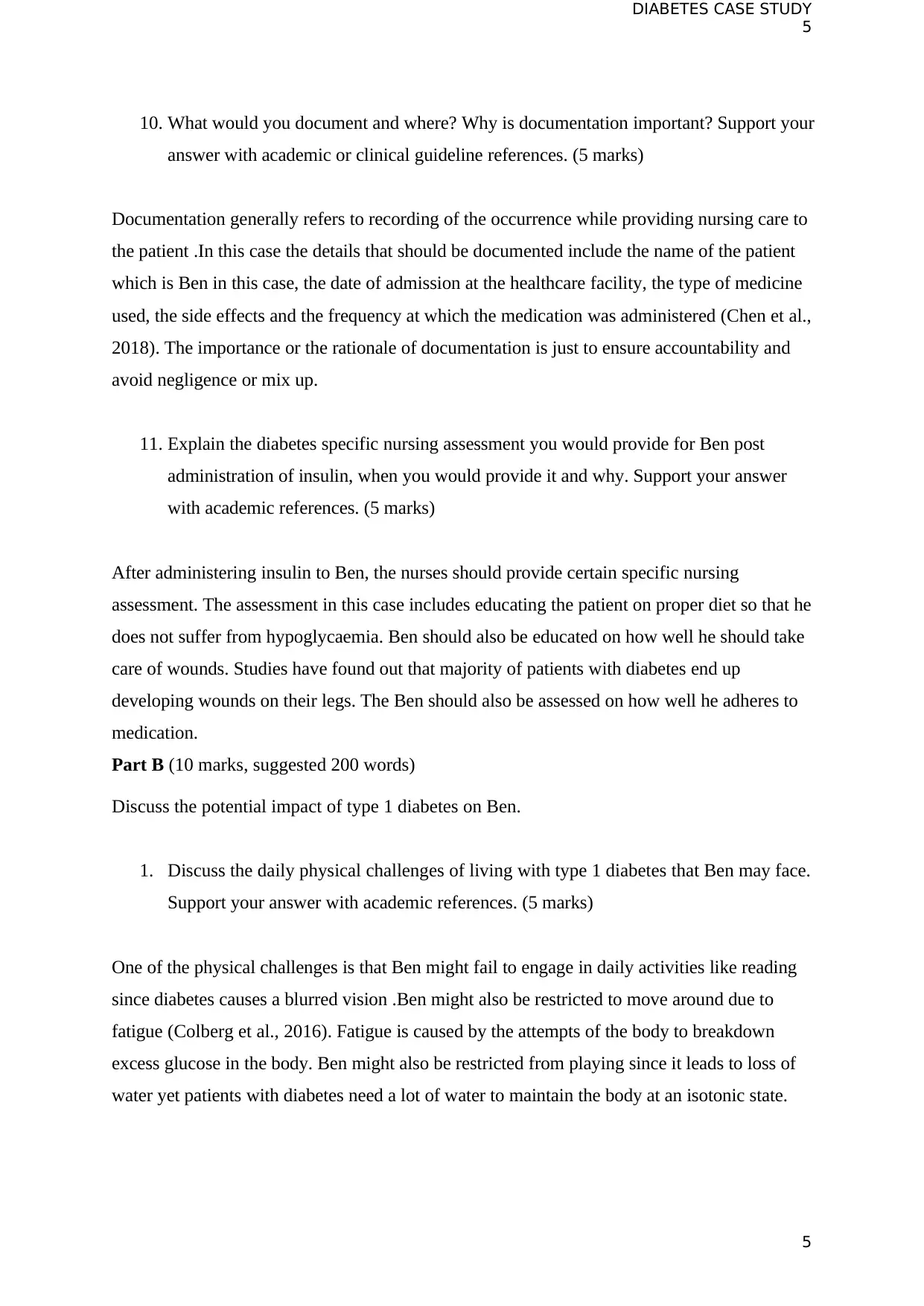
5
DIABETES CASE STUDY
5
10. What would you document and where? Why is documentation important? Support your
answer with academic or clinical guideline references. (5 marks)
Documentation generally refers to recording of the occurrence while providing nursing care to
the patient .In this case the details that should be documented include the name of the patient
which is Ben in this case, the date of admission at the healthcare facility, the type of medicine
used, the side effects and the frequency at which the medication was administered (Chen et al.,
2018). The importance or the rationale of documentation is just to ensure accountability and
avoid negligence or mix up.
11. Explain the diabetes specific nursing assessment you would provide for Ben post
administration of insulin, when you would provide it and why. Support your answer
with academic references. (5 marks)
After administering insulin to Ben, the nurses should provide certain specific nursing
assessment. The assessment in this case includes educating the patient on proper diet so that he
does not suffer from hypoglycaemia. Ben should also be educated on how well he should take
care of wounds. Studies have found out that majority of patients with diabetes end up
developing wounds on their legs. The Ben should also be assessed on how well he adheres to
medication.
Part B (10 marks, suggested 200 words)
Discuss the potential impact of type 1 diabetes on Ben.
1. Discuss the daily physical challenges of living with type 1 diabetes that Ben may face.
Support your answer with academic references. (5 marks)
One of the physical challenges is that Ben might fail to engage in daily activities like reading
since diabetes causes a blurred vision .Ben might also be restricted to move around due to
fatigue (Colberg et al., 2016). Fatigue is caused by the attempts of the body to breakdown
excess glucose in the body. Ben might also be restricted from playing since it leads to loss of
water yet patients with diabetes need a lot of water to maintain the body at an isotonic state.
DIABETES CASE STUDY
5
10. What would you document and where? Why is documentation important? Support your
answer with academic or clinical guideline references. (5 marks)
Documentation generally refers to recording of the occurrence while providing nursing care to
the patient .In this case the details that should be documented include the name of the patient
which is Ben in this case, the date of admission at the healthcare facility, the type of medicine
used, the side effects and the frequency at which the medication was administered (Chen et al.,
2018). The importance or the rationale of documentation is just to ensure accountability and
avoid negligence or mix up.
11. Explain the diabetes specific nursing assessment you would provide for Ben post
administration of insulin, when you would provide it and why. Support your answer
with academic references. (5 marks)
After administering insulin to Ben, the nurses should provide certain specific nursing
assessment. The assessment in this case includes educating the patient on proper diet so that he
does not suffer from hypoglycaemia. Ben should also be educated on how well he should take
care of wounds. Studies have found out that majority of patients with diabetes end up
developing wounds on their legs. The Ben should also be assessed on how well he adheres to
medication.
Part B (10 marks, suggested 200 words)
Discuss the potential impact of type 1 diabetes on Ben.
1. Discuss the daily physical challenges of living with type 1 diabetes that Ben may face.
Support your answer with academic references. (5 marks)
One of the physical challenges is that Ben might fail to engage in daily activities like reading
since diabetes causes a blurred vision .Ben might also be restricted to move around due to
fatigue (Colberg et al., 2016). Fatigue is caused by the attempts of the body to breakdown
excess glucose in the body. Ben might also be restricted from playing since it leads to loss of
water yet patients with diabetes need a lot of water to maintain the body at an isotonic state.
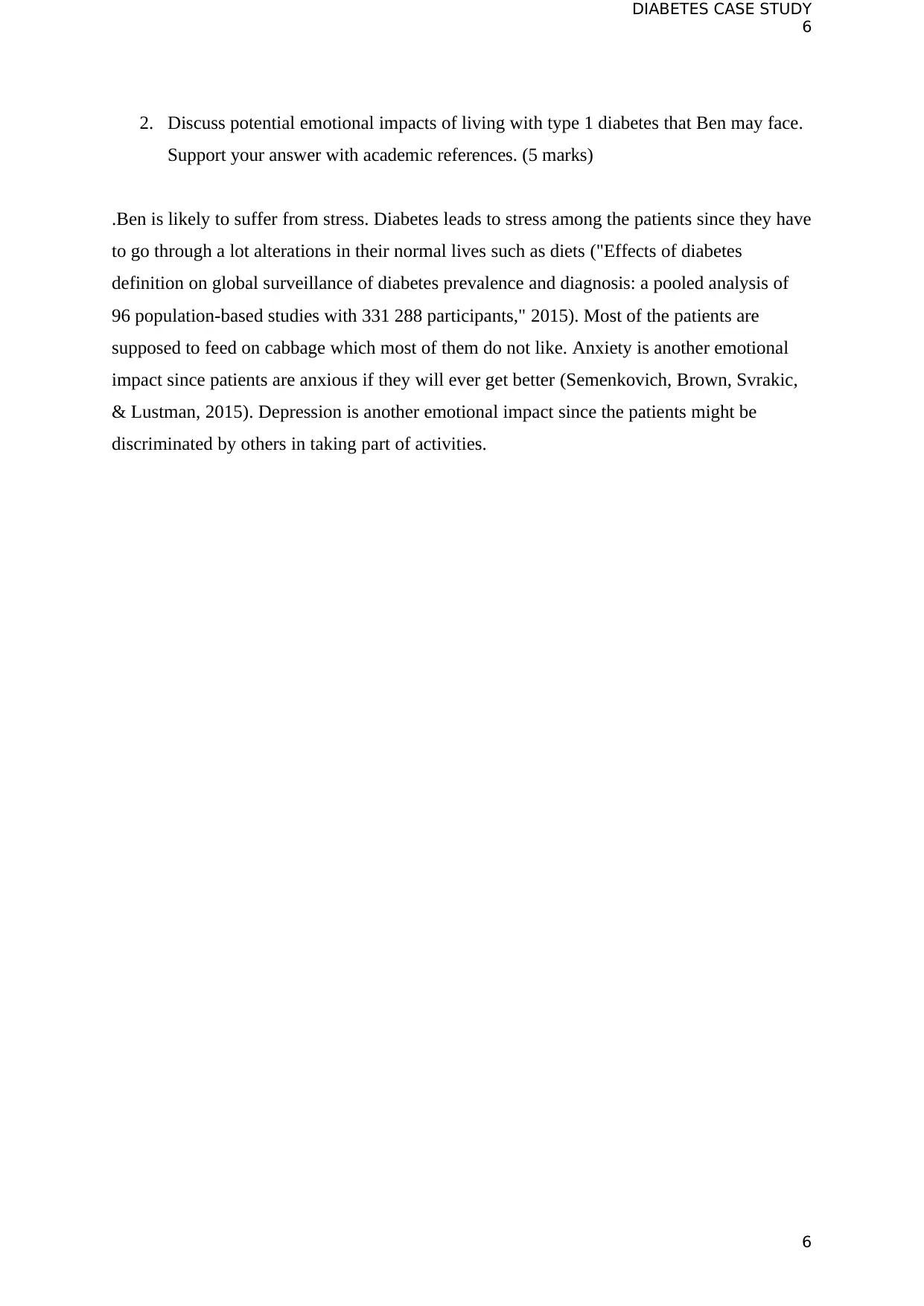
6
DIABETES CASE STUDY
6
2. Discuss potential emotional impacts of living with type 1 diabetes that Ben may face.
Support your answer with academic references. (5 marks)
.Ben is likely to suffer from stress. Diabetes leads to stress among the patients since they have
to go through a lot alterations in their normal lives such as diets ("Effects of diabetes
definition on global surveillance of diabetes prevalence and diagnosis: a pooled analysis of
96 population-based studies with 331 288 participants," 2015). Most of the patients are
supposed to feed on cabbage which most of them do not like. Anxiety is another emotional
impact since patients are anxious if they will ever get better (Semenkovich, Brown, Svrakic,
& Lustman, 2015). Depression is another emotional impact since the patients might be
discriminated by others in taking part of activities.
DIABETES CASE STUDY
6
2. Discuss potential emotional impacts of living with type 1 diabetes that Ben may face.
Support your answer with academic references. (5 marks)
.Ben is likely to suffer from stress. Diabetes leads to stress among the patients since they have
to go through a lot alterations in their normal lives such as diets ("Effects of diabetes
definition on global surveillance of diabetes prevalence and diagnosis: a pooled analysis of
96 population-based studies with 331 288 participants," 2015). Most of the patients are
supposed to feed on cabbage which most of them do not like. Anxiety is another emotional
impact since patients are anxious if they will ever get better (Semenkovich, Brown, Svrakic,
& Lustman, 2015). Depression is another emotional impact since the patients might be
discriminated by others in taking part of activities.
⊘ This is a preview!⊘
Do you want full access?
Subscribe today to unlock all pages.

Trusted by 1+ million students worldwide
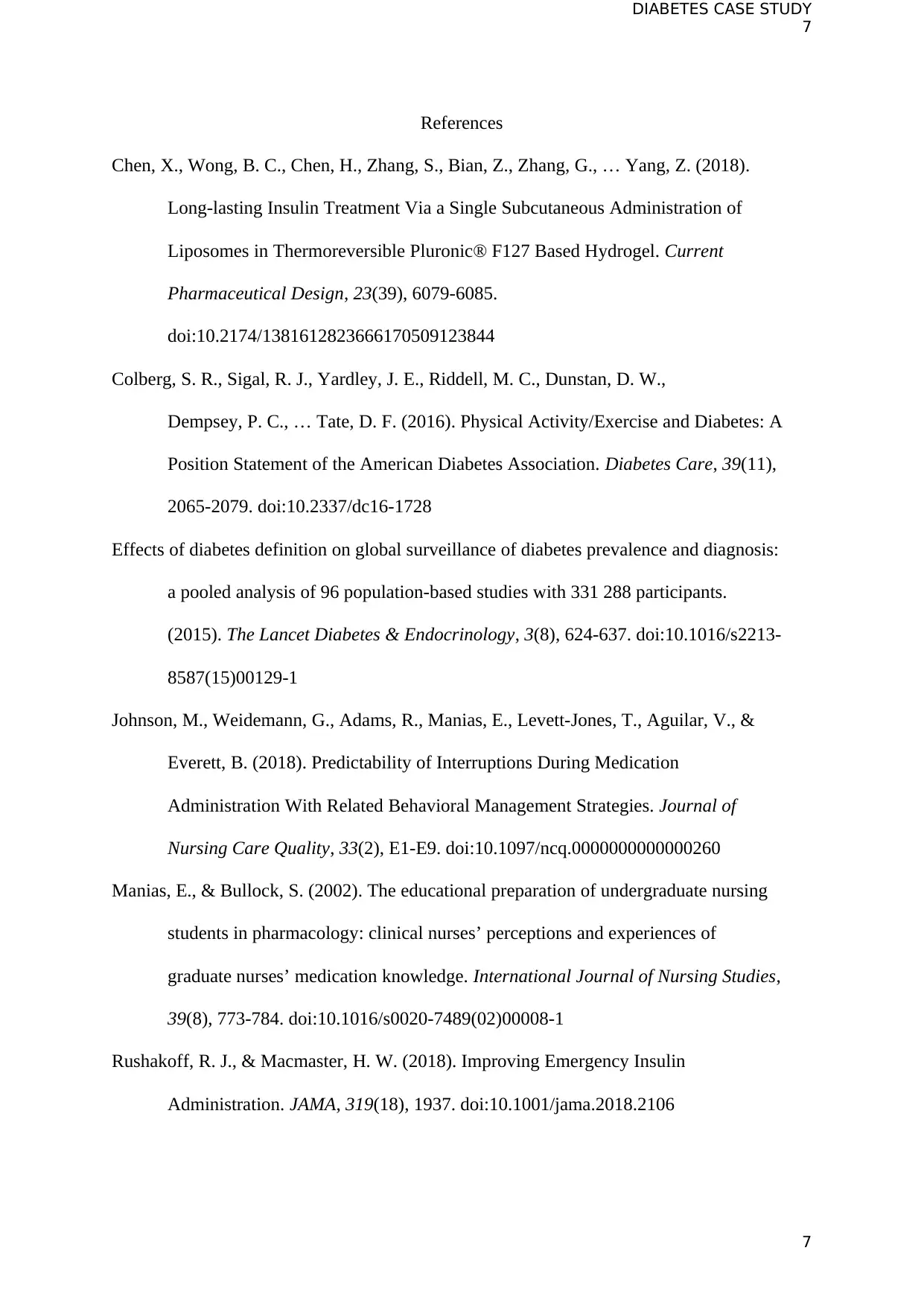
7
DIABETES CASE STUDY
7
References
Chen, X., Wong, B. C., Chen, H., Zhang, S., Bian, Z., Zhang, G., … Yang, Z. (2018).
Long-lasting Insulin Treatment Via a Single Subcutaneous Administration of
Liposomes in Thermoreversible Pluronic® F127 Based Hydrogel. Current
Pharmaceutical Design, 23(39), 6079-6085.
doi:10.2174/1381612823666170509123844
Colberg, S. R., Sigal, R. J., Yardley, J. E., Riddell, M. C., Dunstan, D. W.,
Dempsey, P. C., … Tate, D. F. (2016). Physical Activity/Exercise and Diabetes: A
Position Statement of the American Diabetes Association. Diabetes Care, 39(11),
2065-2079. doi:10.2337/dc16-1728
Effects of diabetes definition on global surveillance of diabetes prevalence and diagnosis:
a pooled analysis of 96 population-based studies with 331 288 participants.
(2015). The Lancet Diabetes & Endocrinology, 3(8), 624-637. doi:10.1016/s2213-
8587(15)00129-1
Johnson, M., Weidemann, G., Adams, R., Manias, E., Levett-Jones, T., Aguilar, V., &
Everett, B. (2018). Predictability of Interruptions During Medication
Administration With Related Behavioral Management Strategies. Journal of
Nursing Care Quality, 33(2), E1-E9. doi:10.1097/ncq.0000000000000260
Manias, E., & Bullock, S. (2002). The educational preparation of undergraduate nursing
students in pharmacology: clinical nurses’ perceptions and experiences of
graduate nurses’ medication knowledge. International Journal of Nursing Studies,
39(8), 773-784. doi:10.1016/s0020-7489(02)00008-1
Rushakoff, R. J., & Macmaster, H. W. (2018). Improving Emergency Insulin
Administration. JAMA, 319(18), 1937. doi:10.1001/jama.2018.2106
DIABETES CASE STUDY
7
References
Chen, X., Wong, B. C., Chen, H., Zhang, S., Bian, Z., Zhang, G., … Yang, Z. (2018).
Long-lasting Insulin Treatment Via a Single Subcutaneous Administration of
Liposomes in Thermoreversible Pluronic® F127 Based Hydrogel. Current
Pharmaceutical Design, 23(39), 6079-6085.
doi:10.2174/1381612823666170509123844
Colberg, S. R., Sigal, R. J., Yardley, J. E., Riddell, M. C., Dunstan, D. W.,
Dempsey, P. C., … Tate, D. F. (2016). Physical Activity/Exercise and Diabetes: A
Position Statement of the American Diabetes Association. Diabetes Care, 39(11),
2065-2079. doi:10.2337/dc16-1728
Effects of diabetes definition on global surveillance of diabetes prevalence and diagnosis:
a pooled analysis of 96 population-based studies with 331 288 participants.
(2015). The Lancet Diabetes & Endocrinology, 3(8), 624-637. doi:10.1016/s2213-
8587(15)00129-1
Johnson, M., Weidemann, G., Adams, R., Manias, E., Levett-Jones, T., Aguilar, V., &
Everett, B. (2018). Predictability of Interruptions During Medication
Administration With Related Behavioral Management Strategies. Journal of
Nursing Care Quality, 33(2), E1-E9. doi:10.1097/ncq.0000000000000260
Manias, E., & Bullock, S. (2002). The educational preparation of undergraduate nursing
students in pharmacology: clinical nurses’ perceptions and experiences of
graduate nurses’ medication knowledge. International Journal of Nursing Studies,
39(8), 773-784. doi:10.1016/s0020-7489(02)00008-1
Rushakoff, R. J., & Macmaster, H. W. (2018). Improving Emergency Insulin
Administration. JAMA, 319(18), 1937. doi:10.1001/jama.2018.2106
Paraphrase This Document
Need a fresh take? Get an instant paraphrase of this document with our AI Paraphraser
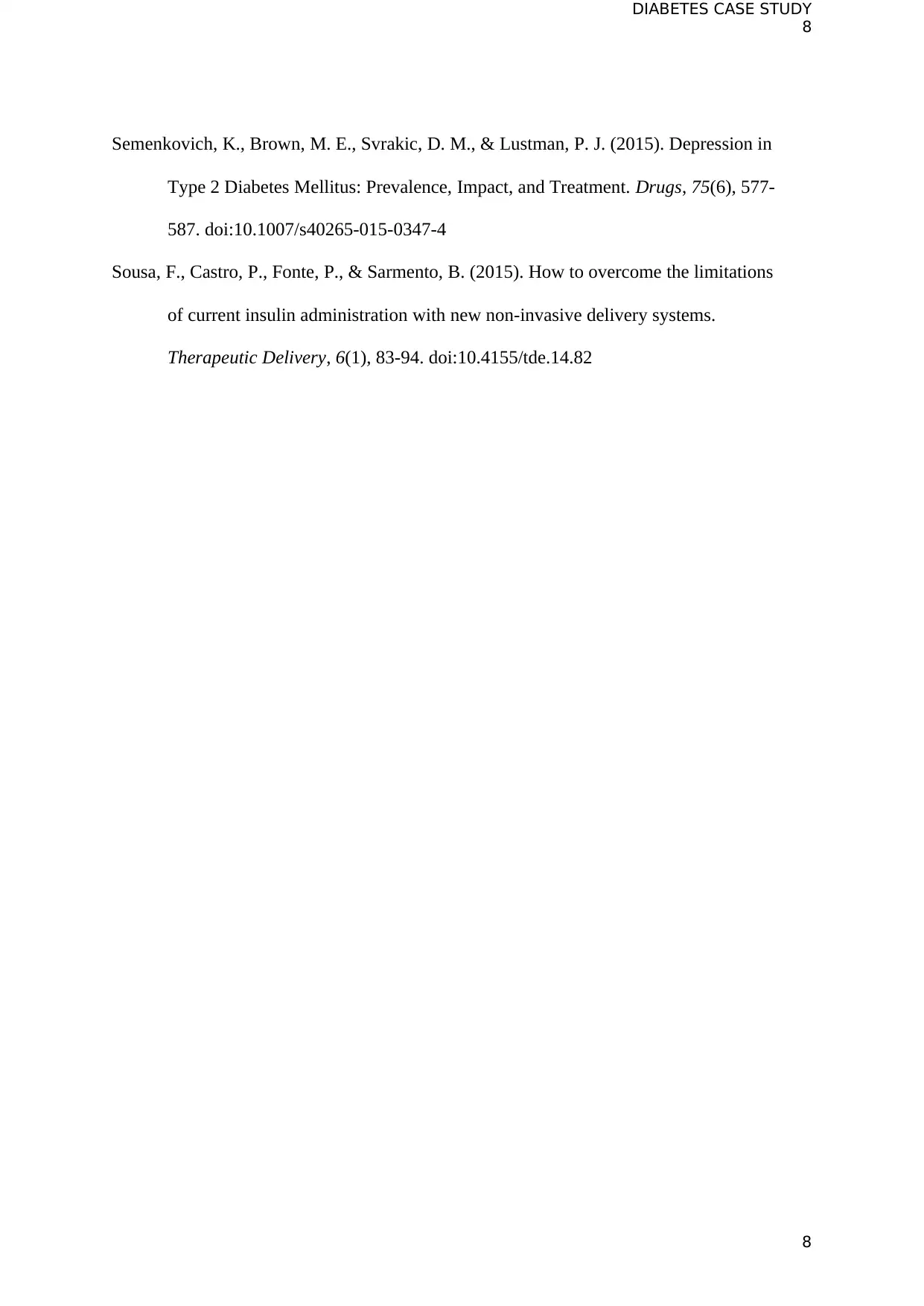
8
DIABETES CASE STUDY
8
Semenkovich, K., Brown, M. E., Svrakic, D. M., & Lustman, P. J. (2015). Depression in
Type 2 Diabetes Mellitus: Prevalence, Impact, and Treatment. Drugs, 75(6), 577-
587. doi:10.1007/s40265-015-0347-4
Sousa, F., Castro, P., Fonte, P., & Sarmento, B. (2015). How to overcome the limitations
of current insulin administration with new non-invasive delivery systems.
Therapeutic Delivery, 6(1), 83-94. doi:10.4155/tde.14.82
DIABETES CASE STUDY
8
Semenkovich, K., Brown, M. E., Svrakic, D. M., & Lustman, P. J. (2015). Depression in
Type 2 Diabetes Mellitus: Prevalence, Impact, and Treatment. Drugs, 75(6), 577-
587. doi:10.1007/s40265-015-0347-4
Sousa, F., Castro, P., Fonte, P., & Sarmento, B. (2015). How to overcome the limitations
of current insulin administration with new non-invasive delivery systems.
Therapeutic Delivery, 6(1), 83-94. doi:10.4155/tde.14.82
1 out of 8
Related Documents
Your All-in-One AI-Powered Toolkit for Academic Success.
+13062052269
info@desklib.com
Available 24*7 on WhatsApp / Email
![[object Object]](/_next/static/media/star-bottom.7253800d.svg)
Unlock your academic potential
Copyright © 2020–2025 A2Z Services. All Rights Reserved. Developed and managed by ZUCOL.





